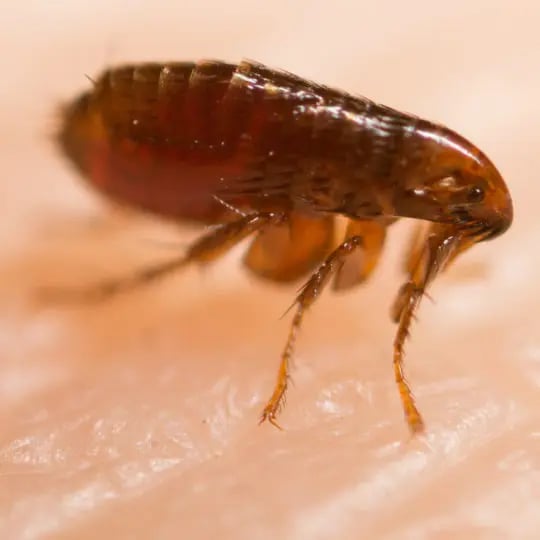Lawn Pest Library
Fleas

Scientific Name: Siphonaptera (from the Greek words “siphon,” or pipe, and “aptera,” meaning wingless)
Lifespan: Two to three months
Brief description: Fleas are wingless parasites that can jump incredible distances to land on their hosts. Using their hind legs as multi-jointed levers, these parasites can leap 100 times their height. A human with a flea’s jumping power could leap over a 30-story building. The most prevalent species of flea in the United States is the cat flea, which dines on the blood of cats, dogs and humans.
What are Fleas?
Fleas are external parasites that feast on the blood of warm-blooded animals. They infest household pets such as cats, dogs and birds, along with wild animals such as rats, raccoons, possums and skunks. Their bites can cause painful, itchy bumps, and they also can transmit serious illnesses such as tapeworm and the once-devastating bubonic plague.
Fleas make themselves pretty comfortable on their host animal, feeding off of them, hitching rides, laying eggs directly onto them, and staying with them for most of their lives. They can also live and breed outside in warm weather.
Fleas can live up to three months, during which time the females can produce 500 or more offspring. The female must have a blood meal before laying eggs. The eggs hatch into larvae, then pupate and transform into adults. Only the adult flea sucks blood. From the time they emerge in their mature form, adult fleas have about seven days to find a blood meal or they die.
The average flea population is 50 percent eggs, 35 percent larvae, 10 percent pupae, and five percent adults. The first three forms of the insect are not easily visible.
Signs and Symptoms of Fleas
Fleas often come with the territory of pet ownership. If your dog or cat is scratching excessively, or has pink spots on its skin, you could have a flea infestation. Fleas often target the hindquarters of a dog and the head and neck of a cat.
Check the areas of the house and yard that your pet spends most of its time. Put on white socks, pull them up over your calves, and walk around your pet’s favorite areas. Any lurking fleas will reveal themselves readily. Make sure to investigate cool, moist, and shady places, such as basement and outdoor furniture, underneath the porch, along fences, and around the edge of the house.
How to Prevent Fleas
Once you have confirmed a flea infestation, clean your home from top to bottom. Make sure to wash linens, pet beds, and clothing. If your pet spends any time in the yard, thoroughly clean it and make it less appealing to fleas. Remove weeds and debris, stack wood neatly, and put away clutter, so that you take away all possible places for fleas to hide. Do not overwater the lawn, because fleas thrive in moisture. Mow and prune regularly to keep the grass exposed to sun. And consider using cedar chips as a decorative accent in the yard. Fleas hate the smell of cedar.
Flea control treatments for the yard include pesticides in spray and tank pump form. If you do the application yourself, be sure to cover up, and remove all toys and personal items from the yard, as the chemicals are highly toxic. Also be sure to keep people and pets away from the treated areas until those regions are completely dry. Carefully follow the instructions on the product label. Most infestations require a repeat application two to three weeks after the initial treatment.
Need Help with Fleas?
Call today at and let's talk about how we can help you with Fleas and other Lawn Pest Library.